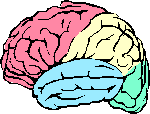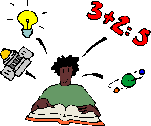Thinking about different ways of thinking

- Works out math problems in his/her head
- Is good at playing chess or other strategy games
- Has highly developed reasoning skills
- Categorizes and classifies objects easily
- Conceptualises abstract ideas very well
- Enjoys the challenge of open-ended tasks
- Is open to experimenting and bringing about change?
Gardner challenged the traditionally held view that intelligence was easy to define and easy to measure and label. `Intelligence' was regarded as a way of describing the ability to learn and do things and was thought to be a uniform cognitive capacity. That is to say, people learn in the same way and at the same rate given the same experiences.
This view of intelligence grew out of the development of the Intelligence Quotient, or I.Q., test. In the early 1900's, Alfred Binet, a French psychologist, devised a test to analyse a child's intelligence in order to uncover weaknesses and allow for appropriate tutoring. I.Q. tests became a near-universal standard for measuring 'raw intelligence' as a way to rank children as more or less capable in school and to predict their future achievement. I.Q. tests are the foundation of the standardised tests used today to determine if pupils and students are performing at an 'average' level for their age. Intelligence was determined, and generally still is, by a youngster's vocabulary skills, reading comprehension, mathematical knowledge and, most of all, the capacity to memorise.
Gardner's theory was a response to what he regarded as an academic and narrow notion of intelligence. He thought that it failed to do justice to the richness of the range of talents that people display. Gardner gathered evidence from studies of:
- brain damage,
- prodigies,
- developmental patterns,
- cross-cultural comparisons,
- various kinds of IQ tests

| Mathematical - Logical | -- | when ordering, discovering cause and effect and quantifying data assists and structures understanding |
| Verbal - Linguistic | -- | when reading, using and listening to words is the most effective way to communicate |
| Visual -Spatial | -- | when seeing how the parts relate and drawing ideas is important to convey information |
| Bodily - Kinesthetic | -- | when actions speak loudest and moving and making is the best way to constructing knowledge |
| Musical - Rhythmic | -- | when music, rhythms, patterns and chanting help in translating and transfering information |
| Interpersonal | -- | when it's important to be in company and work in teams as we gain and give knowledge, skills and support |
| Intrapersonal | -- | when the best company is you, to get a thing done you do it yourself and reflection helps you understand the big picture of life |
Later, Gardner added an eighth intelligence, the naturalistic. This refers to the way some people are informed both about and through the natural environment. They easily recognise and name plants, animals and birds and sort and classify objects.
Each of the intelligences is available to everybody but we are particularly strong in at least one, and often more than one, intelligence. Just as we have a dominant hand, foot and eye we have a dominant intelligence which reflects our preferred way of seeing and dealing with the complexities in our environment. We each gather information differently - some of us prefer auditory means, some of us are visual learners, while others acquire information and learning by tactile or kinesthetic means. Consequently, we prefer to show our understanding through different media, through drawing our solutions, through explaining what we mean, through constructing models or chanting or putting ideas in verse, or perhaps a combination of sorts. The list of ways to demonstrate is as diverse as the demonstrators. The various intelligences are present in virtually every realm of human activity and the significant achievements of mankind involve a blend of intelligences. Gardner writes, "... intelligences typically work in harmony, and so their autonomy may be invisible."
According to the culture and environment in which we live, different intelligences are more highly valued. Due to the impact of the I.Q. test, Western cultures and educational systems have a bias toward the linguistic and mathematical-logical intelligences and these are the subjects that are at the curriculum's core and in which high achievement is rewarded. It is believed that all children can develop and strengthen each of the intelligences given appropriate opportunities within a rich environment and the encouragement to do so by teachers who focus on the individual development of every child.
An understanding of multiple intelligence theory gives educators a new way of reaching out to students. Integrating learning styles into the classroom tasks and assignments can give those students the boost they need to achieve. We should nt be judging an individual's intelligence by the culturally valued view nor by our own preferred way of viewing the world. We need to be open to the idea that people are intelligent in different and surprising ways. Instead of asking, "How intelligent is this child?", the question for teachers becomes, "How is this child intelligent?"

Mathematical-Logical
Intelligence is seen in people who are able to recognise and create logical and numerical patterns. Such people usually enjoy solving mathematical problems in their daily work and lives, being able to order, classify and analyse information, to use reasoning and make predictions. The career paths they take are often in the sciences, in engineering, accountancy, medicine and as professional mathematicians.
Gardner portrays this intelligence at work when a mathematician works through the implications of a theorem and suggests that most successful application is in the scientific method, of making careful measurements, devising statements about the way in which the universe works, and then subjecting these statements to systematic confirmation. Unravelling the logic of a mystery story, piecing together the parts of a complex topic, prosecuting the case in an expose, solving a difficult and important personal problem, are all activities that might be categorised as mathematical-logical.
Albert Einstein, Sherlock Holmes and Bill Gates are examples of people who fall in the category. But we don't have to write equations that will shake the laws of science, create technologies that will shake society, or even think that solving complex problems is elementary to be using our mathematical-logical skills. When bushmen derive elaborate conclusions from a few animal tracks, a pool of people play the lottery and figure out their portion of the winnings, or chess players in a game are intent on the next move we see examples of mathematical-logical intelligence at work.
An awareness of mathematical-logical intelligence impacts classroom practice. Children with high mathematical-logical intelligence need opportunities to explore, experiment in order to exercise and strengthen this intelligence across the curriculum.
- Encourage awareness of number in the environment and how we use mathematics in our everyday activities
- Teach to and provide opportunities for a variety of problem solving strategies
- Have pupils sequence steps in solving a problem and create flow charts
- Allow children to create categories by which to sort and classify objects
- Encourage the use of Venn or Caroll diagrams to show classes of objects
- Use number and strategy games in lessons and have pupils design and construct their own games
- Give tests to students that will be more like brainteasers and will help the pupils use their logical ability
- Provide projects and exercises which will give an opportunity for exploring, hypothesising, experimenting by changing variables and predicting outcomes
- Develop a logic puzzle corner and encourage all pupils to contribute to it
- Use an interdisciplinary approach that allows students to discover scientific and mathematical connections in history, geography, social studies, and literature.
